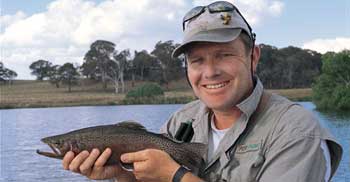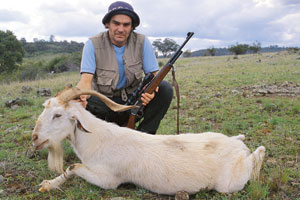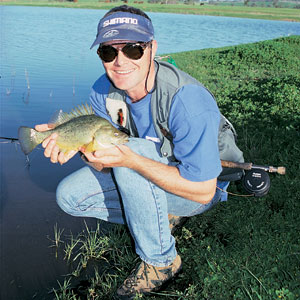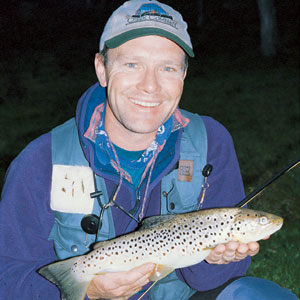The goat that caught a trout
by Richard Barnsley
Hunter 2
 Fifty metres upstream I watched Dad flick a lure into the head of the
pool. The current was fast and he allowed the tiny jig to wash into the
fast water. On his third cast the lure swept out into the deeper water and the old fella was rewarded with a savage strike.
Fifty metres upstream I watched Dad flick a lure into the head of the
pool. The current was fast and he allowed the tiny jig to wash into the
fast water. On his third cast the lure swept out into the deeper water and the old fella was rewarded with a savage strike.
The rod bent hard as the fish headed downstream before turning into the heart of the pool and leaping twice. Gradually, the trout tired and the old fella gingerly steered him to the waiting net. Another fish had fallen for the hair-tailed jig.
During the past 20 years, my hunting has shared a place with fly fishing and mountaineering as my outdoor passions. High cliffs and remote streams have been as much my playground as game country.
As time passes you tend to blend the distinctions that once defined you until they become blurred. Today a lot of my fly-tying materials come from the game I hunt. Deer, goat, rabbit and fox all contribute excellent fly-tying resources and have assisted me in outwitting plenty of fish.
 The design of a fish-nailing fly or lure is a great achievement, more
so if it proves to be a consistent fish taker. American angler Bob
Clouser designed a pattern some years ago for taking deepwater bass and
today the Clouser Minnow has taken just about everything that swims. A
simple fly to tie, variations are also suitable for anglers who fish
with conventional spinning tackle.
The design of a fish-nailing fly or lure is a great achievement, more
so if it proves to be a consistent fish taker. American angler Bob
Clouser designed a pattern some years ago for taking deepwater bass and
today the Clouser Minnow has taken just about everything that swims. A
simple fly to tie, variations are also suitable for anglers who fish
with conventional spinning tackle.
It is not unusual that most Aussie game country has good fishing. The mountains that contain our deer herds are almost all very good trout country and the rugged gorges where trophy billies dance the heights offer excellent bass or yellowbelly. The buffalo plains and pig swamps of the Northern Territory are handy to barramundi, queenfish and saratoga.
The hunter who packs a rod and reel and a handful of hand-tied Clousers would be well equipped to mix it with any of these fish. Varying the colour combination and size of the jigs and flies will allow you to target various species.
Originally, the Clouser pattern was designed using American bucktail or whitetail deer hair, although throughout the years I’ve enjoyed great success using Aussie feral goat hair. Forget the wild and woolly cashmere coats; when hunting for hair you want the coarse fibres of the true feral.
 The tail is a great source but I also take portions of the hide, salted
down and frozen till I’m ready to tie up a batch of lures. It is
possible to dye hair patches with the readily available Dylon dyes,
which you can obtain from most sewing or fabric stores. The amount of
time you soak the hair will dictate the strength of colour.
Alternatively, be selective when harvesting goats, as there are plenty
of coloured skins out in the hills.
The tail is a great source but I also take portions of the hide, salted
down and frozen till I’m ready to tie up a batch of lures. It is
possible to dye hair patches with the readily available Dylon dyes,
which you can obtain from most sewing or fabric stores. The amount of
time you soak the hair will dictate the strength of colour.
Alternatively, be selective when harvesting goats, as there are plenty
of coloured skins out in the hills.
I’ve included instructions for variations of this fly later in the article. To begin tying flies and hair jigs we need a system to securely hold the hook and the best of these is a proper fly-tying vice. These can be purchased from most fishing stores for as little as $20 and are a cheap, yet worthwhile, investment.
The materials you will need are basic: the relevant hook, goat or deer hair, lead dumbell eyes or small split shot sinkers and tying thread. If you intend to fish with fly fishing tackle, the preferred weighting is a dumbbell eye.
Using the dumbell eyes causes the fly to ride upside down, hook uppermost, and this reduces the risk of snagging on weed and underwater structures.
If, however, you find these difficult to locate, purchase a short length of washbasin plug chain - the bead type. Snip two jointed balls from the chain with pliers and there are your dumbell eyes. Lure anglers will find the jig easier to cast by using the split-shot lead method.
You will also need a bobbin to hold the thread and you can make a very basic one by placing the thread in a plastic film canister. Poke a hole in the wall just below the cap and pull the thread through. By holding the canister you can manipulate the thread a lot easier. Otherwise, bite the bullet and spend a couple of bucks on a fly-tying thread bobbin from your local tackle store.
 The Clouser Minnow is very easy to fish. In smaller streams where trout
and bass may be the target it is best to cast upstream and allow the
Minnow to tumble back down along the bottom. Occasional lifts of the
rod tip will cause it to jump up off the bottom in an animated fashion.
The Clouser Minnow is very easy to fish. In smaller streams where trout
and bass may be the target it is best to cast upstream and allow the
Minnow to tumble back down along the bottom. Occasional lifts of the
rod tip will cause it to jump up off the bottom in an animated fashion.
On either side of the Great Divide, bass and yellowbelly are common. Here the preferred tactic is to cast close to the shoreline, targeting areas where undercut banks or fallen trees are evident. Allow the offering to sink down the face of the structure then jig it to the surface by raising and lowering the rod tip.
In coastal estuaries, this fly/lure can be deadly on flathead and bream. Indeed southern anglers will enjoy some great action using small sizes on whiting grounds. Again the go is to cast out, allow the minnow to sit, then retrieve very slowly with plenty of rod action to jump and dart the fly through the sandflats and along rock breakwalls.
North in the tropics it is not unusual to slowly troll Clousers along rock bars and reefs. Similarly, many aggressive tropical species will hammer these lures on the drop when sinking.
This past summer a group of us spent a weekend fishing at South West Rocks on the NSW north coast. Despite having caught numerous species on fly tackle, I’d always wanted to tangle with mahi mahi or dolphin fish. Luckily, the season was good and on the first morning out I smoked the fly reel on a dozen or more of these acrobatic, blue water speedsters - all on home-tied Clousers.
 The Clouser Minnow is a well-respected fish catcher worldwide. You can
cast it, troll it and jig it for plenty of action out on the water.
Simple to construct, it just may cause you to review the way you look
over that next mob of feral stinkers.
The Clouser Minnow is a well-respected fish catcher worldwide. You can
cast it, troll it and jig it for plenty of action out on the water.
Simple to construct, it just may cause you to review the way you look
over that next mob of feral stinkers.
Tying Procedure
- Place hook in vice with
point down.
- Lay thread along hook then over bind.
- Crimp on split shot of relevant weight. Remember if it is to be
used on spinning tackle then you will need more weight than on fly
gear. If using bead chain eyes lay at 90 degrees to shank and bind down
with criss-cross wraps. Add a drop of super glue.
- Tie in a clump of hair fibres on top of the shank so that they
extend just beyond the hook bend. If you are tying a two-coloured fly
use the lighter hair at this point. Trim away the butt ends.
- Tie in another clump of hair below the hook, slightly thicker
than the first. Trim away waste.
- Finish fly by tying a couple of half hitches behind the hook eye
and cut thread.
- Coat the wraps with clear fingernail varnish. You can paint the split shot white and add two eyes with a match end dipped in black paint. Eyes are an important attack trigger for many fish, particularly in saltwater. Coat head with varnish.
